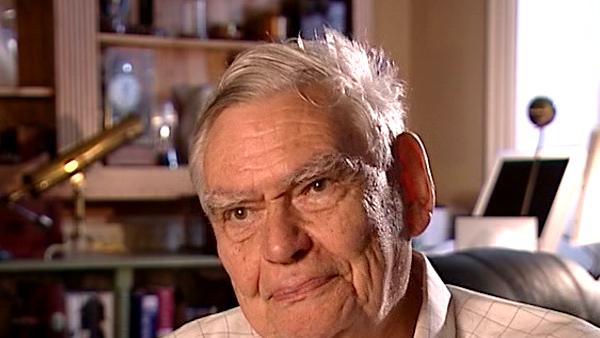Well, this is a chap who was called Sidney Bradford, he’s always known as SB, and my assistant, Jean Wallace, saw in her local newspaper that he was going to have an operation on his eyes, you see. After 52 years, he was 52 and he’d been blind since he was born or at least a very few months old, so we shot up to the hospital. It was really quite dramatic and I shoved everything in the car I could think of that we might be able to use to test his new gained sight using basically the stuff from my practical class because I do practical class on vision, you see, and we shot up there and lo and behold it was all true. He’d just had the operation done the day before and we were installed in the hospital. The surgeon, Mr Hirtenstein, his name, was extremely helpful to us, it was really good, and there was this dramatic thing, this chap who’d been blind all these years, what would be able to see? Well, when he first opened his eyes, he saw a complete blur and then he realised it must be the surgeon’s face because the voice was coming out of it so, oh, golly, that’s a face, sort of thing, you see, and that was actually the day before we got there. We got there the next day but it was just really a blur and a nonsense to him, the first day. But by the time we saw him, the day after, really it was quite remarkable. He could really begin to see things that he already knew, this was a critical point. I’ll give you an example, if I may. This was about three days after the operation, he had a big watch, which he had in the upper pocket of his coat, and he’d take this out and he’d feel it. It had no glass, you could open it, and he’d feel the hands and he could tell the time. Now, when we showed him or he saw the clock in the wall of the hospital, he could immediately tell the time so I borrowed an alarm clock from a nurse, twiddled the hands round several times and he could tell the time. I mean he just didn’t sort of know it was teatime, he could tell the time by sight without us having to teach him, this was the point. We also found that he could read upper case letters. He could read capital A, capital B, but he couldn’t read a lower case e but he could read an upper case E and so on. We found that the kids in the Blind School had been taught to read upper case letters on brass plates with their fingers. They were taught this because it was quite useful to them but they’d not been taught lower case letters, squiggly letters, you see. So they’d done an experimentfor us. So we established really that when he had touch information as a baby he could see immediately, 52 years later when he’d had the operation, that the knowledge from touch served for his new found vision and this really switched me on to the whole idea of knowledge being absolutely vitally important to see, you know. The other thing we found was that he was remarkably free of illusions because having taken all this stuff up from my practical class, I had a load of illusions and he didn’t get them so all my students got these illusions but he didn’t, see what I mean? And that really struck me. So I then realised that part of the reason for illusions is not the physiology going wrong which was the prevalent view at that time, the signals in the nervous system, but that the brain couldn’t make sense of them without knowledge so the illusions were not misleading to him when they were not using knowledge that he had available. Of course it was restricted because he only had this touch knowledge, you see what I mean?
Could he recognise trees and buses?
Yes. I got him to draw buses actually. He loved transport. His great regret was that he couldn’t drive. He was dying to be able to drive a car. He never did drive in actual fact but I got him to draw a bus and the first drawing was a touch bus, like a blind man draws it, mainly from the inside and he never could draw the, from memory anyhow, or the imagination, the front of the bus, the bonnet. He couldn’t draw it at all. He could only draw bits that he knew from touch, which was really quite interesting, and this remained so. He added bits onto it including writing in later drawings but they were basically touch drawings, like a blind man’s touch. Touch dominated completely, you know, but it was this business about- that he could only see things that he knew about it. For example, he could judge distances horizontally, it was a big ward he was in and he could judge the distances of tables and chairs amazingly well. I got him to look out of the window. It was about 60 foot high, really high window, and he said very clearly to me- yeah, I could hang from the window sill with my fingers, my feet would touch the ground, and he couldn’t see vertically longer than his own body length, see what I mean? He had to experience the distances to see them, all the shapes, to see them. I thought that was amazingly interesting so that you calibrate yourself when you’re a child by walking around, touching things, handling things, and then looking at them at the same time, then your visual brain learns in coordination with exploratory touch.






